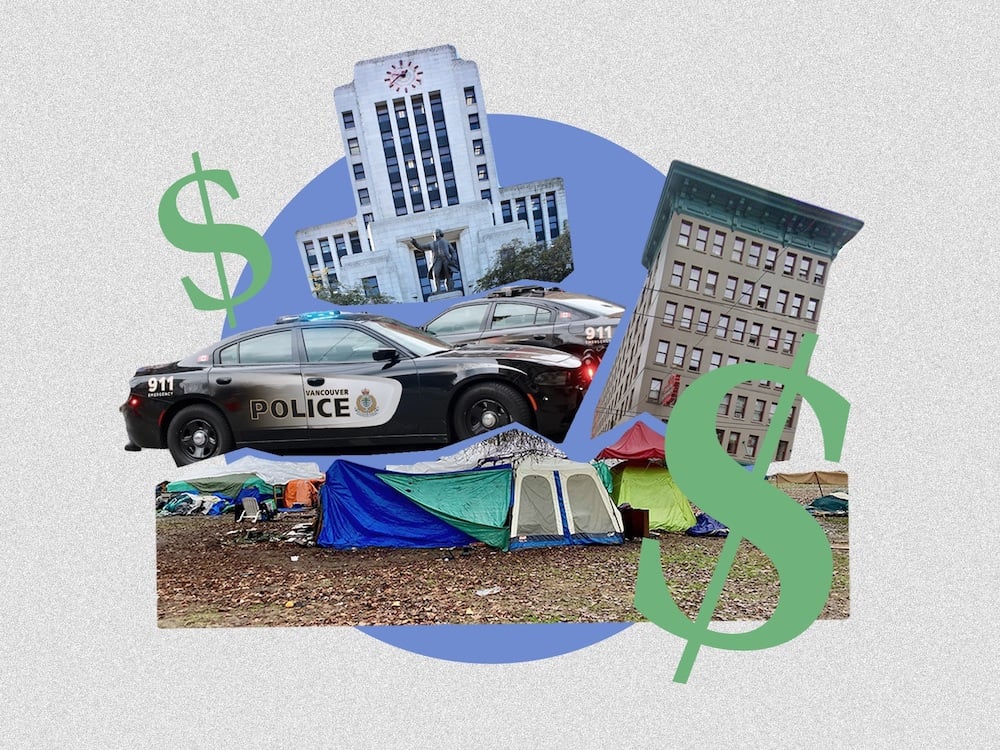Non-profits are generally viewed as positive forces in society. Or, at the very least, neutral.
However, the 22 authors of “Situating the Non-profit Industrial Complex,” a new paper in the peer-reviewed journal Social Sciences, have documented the ways in which non-profits in the realms of housing, health, research and social services are structured in ways that can work against their altruistic aims.
The authors, many of whom work and live in the Vancouver area, argue in the report that non-profits are part of a tangled web of power that makes it hard for them to be held accountable and tackle the social issues they say they’re committed to solving.
Governments get to “shirk responsibility” for inequality and decreased social spending by instead funding non-profits in the community, say the authors. And as non-profits grow, they become focused on generating revenue to maintain operations, weakening their accountability to those they serve.
“We’re talking about non-profits hiding government austerity,” said Tyson Singh Kelsall in an interview with The Tyee. He is a PhD candidate in Simon Fraser University’s faculty of health sciences and one of many authors who is also employed as a frontline worker in the Downtown Eastside.
“We see all this political theatre. This paper came to be because so many of us were seeing government announcements and money put into problems that shouldn’t be that difficult to solve.”
A number of major news stories this year highlight the extent of this problem, he said.
There was the forensic audit that found that a longtime BC Housing CEO directed funds to Atira, led by his spouse, which became the largest non-profit supportive-housing operator in the province. Workers and tenants had been raising alarms about problems at the buildings for years.
In 2022, the Winters Hotel, operated by Atira’s for-profit arm, burned down, killing two tenants. The Tyee investigated and reported extensively on the scandals.
Then there was the elevator that has been breaking down for over a year at the Portland Hotel, one of 30 buildings run by the Portland Hotel Society. It has resulted in serious health problems for the building’s supportive-housing tenants.
The non-profit said that the elevator was old and replacement parts were not readily available. Singh Kelsall and other authors questioned why a non-profit with a manager that earns around $275,000 and executives that make close to that would have a building with a faulty elevator.
‘A nice way to maintain the status quo’
The authors frame their arguments around what scholars call the “non-profit industrial complex.”
The term refers to what the authors say is a problematic, inequitable funding and operational structure that ultimately protects governments, elected officials and private donors.
“The non-profit industrial complex is a nice way to maintain the status quo while feeling like something is being done,” said co-author Jenn McDermid, a PhD candidate in interdisciplinary studies at the University of British Columbia.
What’s unique about Vancouver’s context is the clustering of non-profits in the Downtown Eastside, say the authors, a neighbourhood where many residents deal with poverty, housing insecurity and health issues.
Some non-profits in the Downtown Eastside have partnerships and collaborations with the police. Community policing centres, five of which are in and around the neighbourhood, are considered non-profits, for example. In 2021, a Globe and Mail investigation revealed that prominent real estate developer Peter Wall donated $1 million to the Vancouver Police Department’s charity foundation, with half of that money intended for community policing centres and the other half to provide resources for officers dealing with people with mental health or addiction issues.
“The diffusion of responsibility plays out in so many ways,” said Singh Kelsall. “Governments will point fingers at non-profits. Non-profits will point fingers at government. On the street level, we see the same thing: ‘We don’t deal with that here; go to this other non-profit.’ Ultimately, it fragments care. It’s not a relational model.”
The authors explain their findings with The Tyee.
On the roots of the ‘industrial complex’
The mix of public and private power in the delivery of social welfare has a long history in Canada and a hand in colonization, the authors note in the paper. Christian churches and residential schools are one prominent example.
They also draw similarities between the non-profit industrial complex and English Poor Law legislation.
As they write in the report, “both produce status and a salary for those in upper-level positions; both use business structures that underbid each other and subject people living in poverty to surveillance, violence and control.”
On the lack of transparency
Non-profits rely on the funding of donors and the governments of the day.
However, they aren’t obligated to release accounting records, meeting minutes or annual reports and are not subject to freedom of information policies.
If board members misuse funds, preside over harmful practices or act against the non-profit’s mandate, there aren’t many ways for service users to hold them accountable.
According to the Societies Act that regulates them, there is one thing that non-profits must publish: what their highest-paid employees are making.
On the inability to speak up
“Oftentimes, non-profits prioritize the funders rather than the people they purport to support,” said McDermid.
This makes it especially difficult for non-profits to criticize governments that hold the purse strings.
“They don’t want to rock the boat,” said McDermid. “They don’t want to bite the hand that feeds.”
The article’s authors cited an amendment earlier this year by Vancouver city council, currently dominated by the ABC party, that non-profits applying for municipal funding need to be “respectful.”
The city pulled funding from one non-profit, the Vancouver Area Network of Drug Users, that has criticized the ruling party’s policies. The city cited a “misuse” of funds based on allegations in the media, reasoning that the non-profit rejected.
On April 5, when the city and police cleared the tents of people sleeping rough on Hastings Street, the authors noted, many non-profits in the neighbourhood remained silent or did not take a stance until much later. Instead, it was individual workers and community members who decried the “street sweeps” and distributed gear for those displaced.
It is also difficult for non-profits to take a public stance on issues considered controversial, such as Palestinian solidarity, that might upset funders, added Singh Kelsall.
On big players and bureaucratization
The model of non-profit funding in which they are largely supported by funding from governments has resulted in bureaucratization, with complicated results, say the authors.
Among the outcomes: more rules, more paperwork and more public servants needed to administer non-profit programs, all of which take resources away from the people most in need of the services provided.
Rather than directly offering material support to those who need it, funding for social programs has become an act of negotiation, the authors write.
In the Downtown Eastside, it’s a “hyper-competitive” landscape, said Singh Kelsall.
It’s hard to know how many non-profits there are in the neighbourhood today. Back in 2014, the Vancouver Sun counted 260, but that calculation also includes individual shelters and buildings with supportive housing.
Amid the competition, the largest non-profits with the most resources have become “too big to fail, and they dominate contract negotiations and steer the political direction quite often,” said Singh Kelsall.
About 60 to 80 per cent of non-profit funding in Canada comes from public money. This reliance can result in non-profits adjusting their services to match government priorities, shifting accountability away from the community and to their public funders.
“We hear about these funding announcements and these big reveals,” said co-author Jake Palmour, a registered social worker who also works in the neighbourhood.
“Oftentimes, that translates into top-heavy management, big six-figure salaries for people who aren’t doing as much as they could be. Those resources could be used on the frontline. It’s hard not to become demoralized.”
On ‘poverty pimps’
The non-profit industrial complex isn’t just being critiqued by voices on the left.
Populist voices on the right, in their calls for more law and order, blame non-profits and activists for profiting from poverty.
They’ve used derogatory terms like “poverty pimps,” which has been bandied about for years and showed up in a December 2022 Daily Hive column, and the “homeless industrial complex,” which the same author wrote about in the National Post earlier that year.
But the report’s authors write that such framing “blames people living outside, and those attempting to provide support, for various societal ills that are, in reality, fuelled mostly by poverty, growing inequality, a housing crisis and prohibition.”
Despite the criticism, the authors point out that right-wing policies often call for less social spending, which ironically is what led to the rise of non-profits to fill the gap in services.
Anti-poverty advocates note that lack of social spending has contributed to widespread food insecurity, which has increased demand for services like food banks. And the report’s authors note how large non-profits can become mired in regulatory processes that ultimately undermine equitable access to the services they are providing.
The Greater Vancouver Food Bank, for example, requires new users to book an appointment in advance and bring government picture ID for each person in their household who needs food. There was a plan halted by the pandemic to require proof of low-income status.
On the exhaustion of mutual aid
“The Downtown Eastside is a place where mutual aid flourishes considering how few resources there are,” said Singh Kelsall. “It brings out a lot of care in the people who’ve become a part of it.”
However, this means that the workers who go beyond non-profit mandates to care for their clients’ unmet needs put in informal and unpaid labour.
“I try my best to be accountable to the people I work alongside, who I sometimes call clients,” said Palmour. “Other people are accountable to funding amounts.”
And those are the people who end up getting promoted to high positions in non-profits, he added.
“We say this a lot about Downtown Eastside non-profits: people fail upward.”
Singh Kelsall said that the authors aren’t calling for governments to reduce social spending, and that even the investigation of “bad apples,” like the B.C.-commissioned audit of Atira, doesn’t strike at the heart of the issue.
Rather, the report is an attempt to examine the power relations behind a system that can slow or interrupt aid to the people and problems that need it.
There’s a need to “take out some of these middlemen,” said McDermid, “and ensure that resources are redistributed equally and not reinforcing these hierarchies of wealth and power.” ![]()
Read more: Rights + Justice, Politics

















Tyee Commenting Guidelines
Comments that violate guidelines risk being deleted, and violations may result in a temporary or permanent user ban. Maintain the spirit of good conversation to stay in the discussion and be patient with moderators. Comments are reviewed regularly but not in real time.
Do:
Do not: